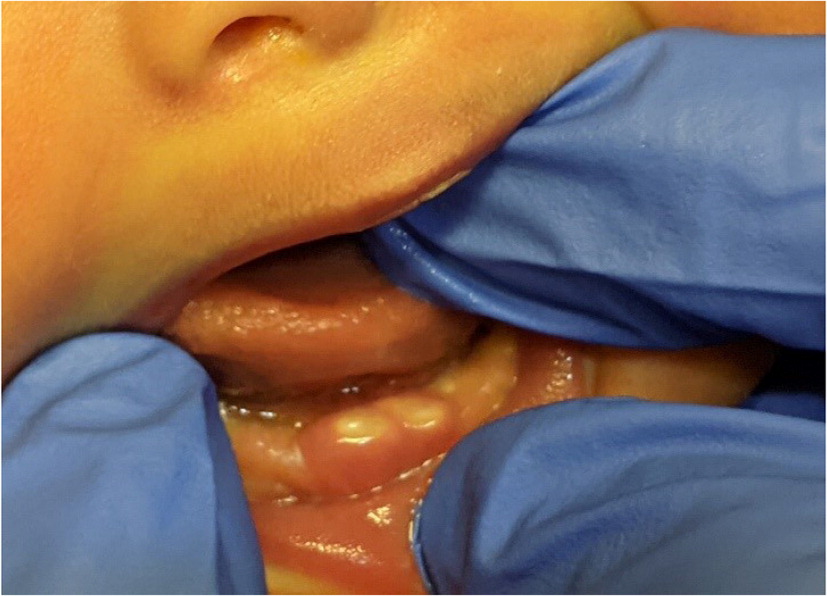
Am Fam Physician. 2022;106(4):online
Author disclosure: No relevant financial relationships.
To the Editor: A mother (gravida 3, para 3) and her four-day-old female infant, born via normal spontaneous vaginal delivery, presented to our Federally Qualified Health Center for the infant's first examination after discharge. Based on the mother's preference, the infant was exclusively formula feeding without difficulties. At discharge, the infant had Epstein pearls on the lower gums, congenital dermal melanosis on the sacrum, and a hymenal tag.
A physical examination in the clinic found swelling of the mandibular gum with two protruding, white, mobile teeth on the anterior mandible with inflamed gingiva (Figure 1). The infant's vital signs were normal, and she was gaining weight. Radiography indicated supernumerary natal teeth, and pediatric dentistry recommended extraction; however, removal was delayed because of insurance issues and the COVID-19 pandemic. The teeth were extracted without complications when the infant was about six months old. The swelling and gingival inflammation had caused the teeth to appear similar to Epstein pearls at the hospital discharge examination.

Natal and neonatal teeth are rare but can be diagnosed by pediatricians and family physicians during the infant's initial examination. The incidence ranges from 1 in 2,000 to 1 in 3,500.1 Natal teeth are present at birth and are slightly more common than neonatal teeth, which erupt within the first month of life.1 Complications can include laceration of the tongue, poor feeding and growth, and pain or injury to the parent who is breastfeeding.
Natal and neonatal teeth usually occur in pairs in the central mandibular incisors, followed by the maxillary incisors.1,2 The etiology is not well understood, but it is widely accepted that the superficial position of the tooth germ predisposes the tooth to erupt early.3 Contributing factors include maternal vitamin deficiencies, poor maternal health, maternal endocrine disorders, and congenital syphilis.2,3 Some syndromes, including cleft lip or cleft palate, may be associated with the presence of natal and neonatal teeth.4
Radiography is needed to distinguish supernumerary teeth from the more common prematurely erupted primary deciduous teeth.1,2 Supernumerary and mobile or unstable primary deciduous teeth must be extracted. Asymptomatic primary deciduous teeth require no further treatment unless they are interfering with feeding or growth or if there are concerns for other complications.2
